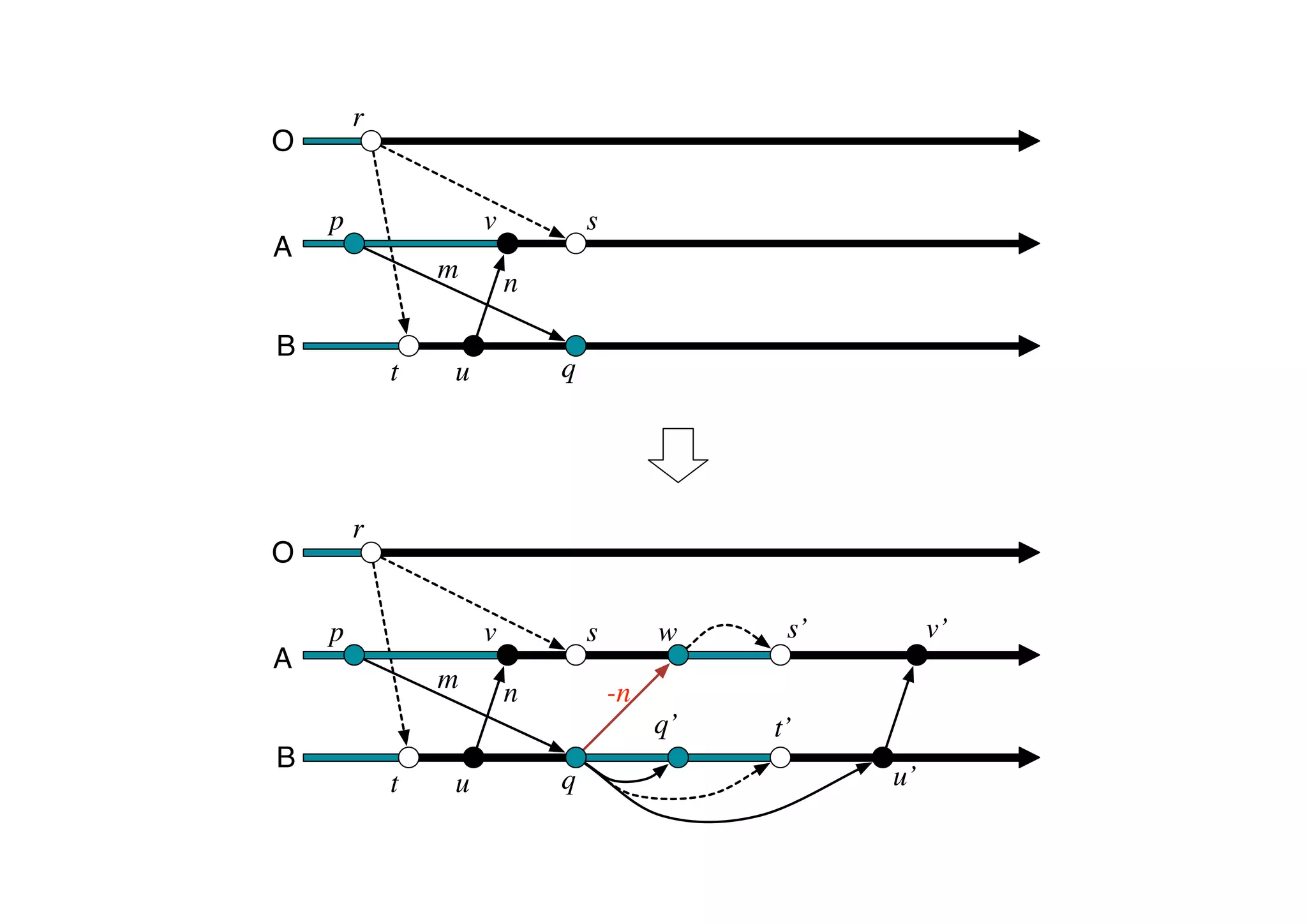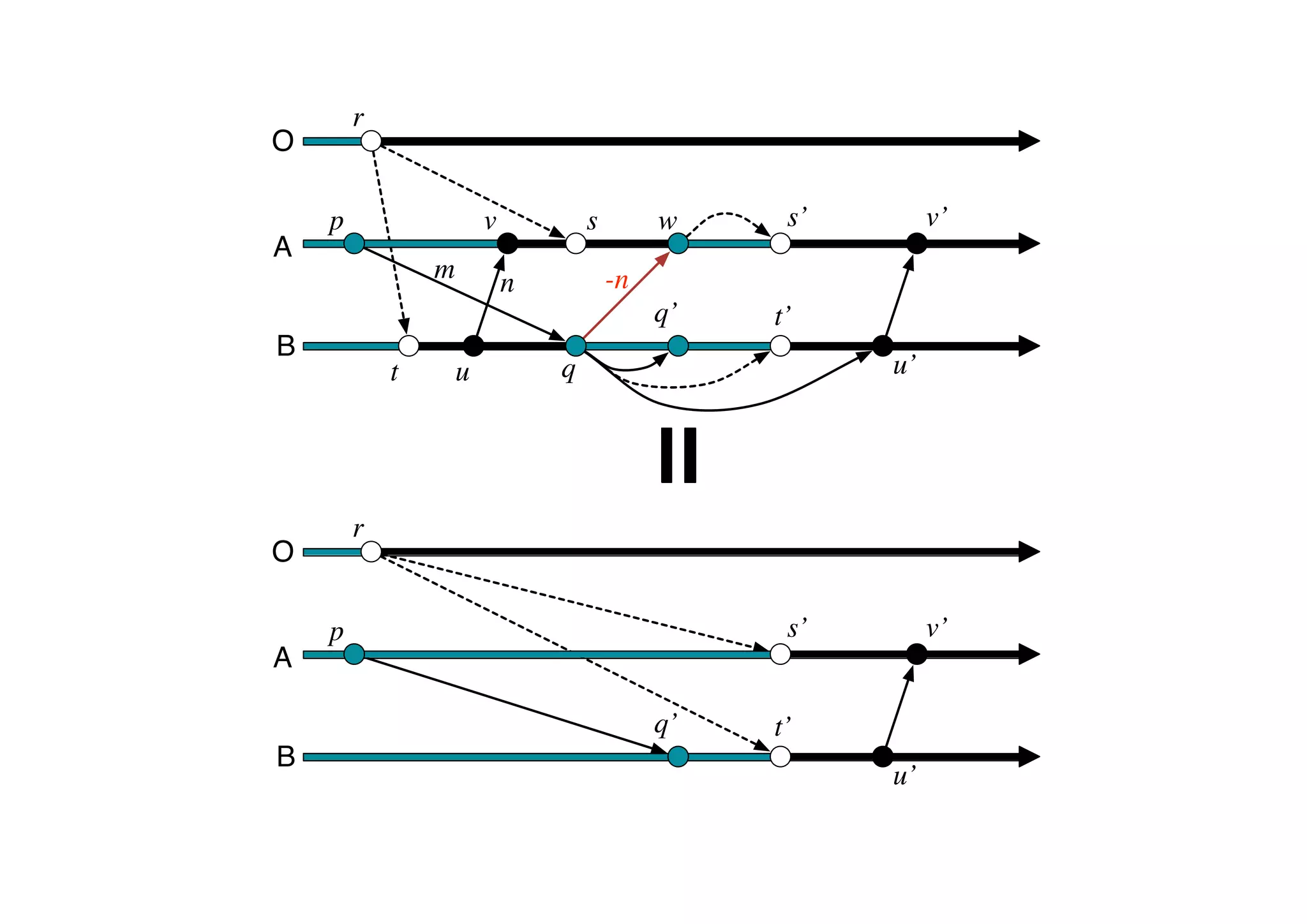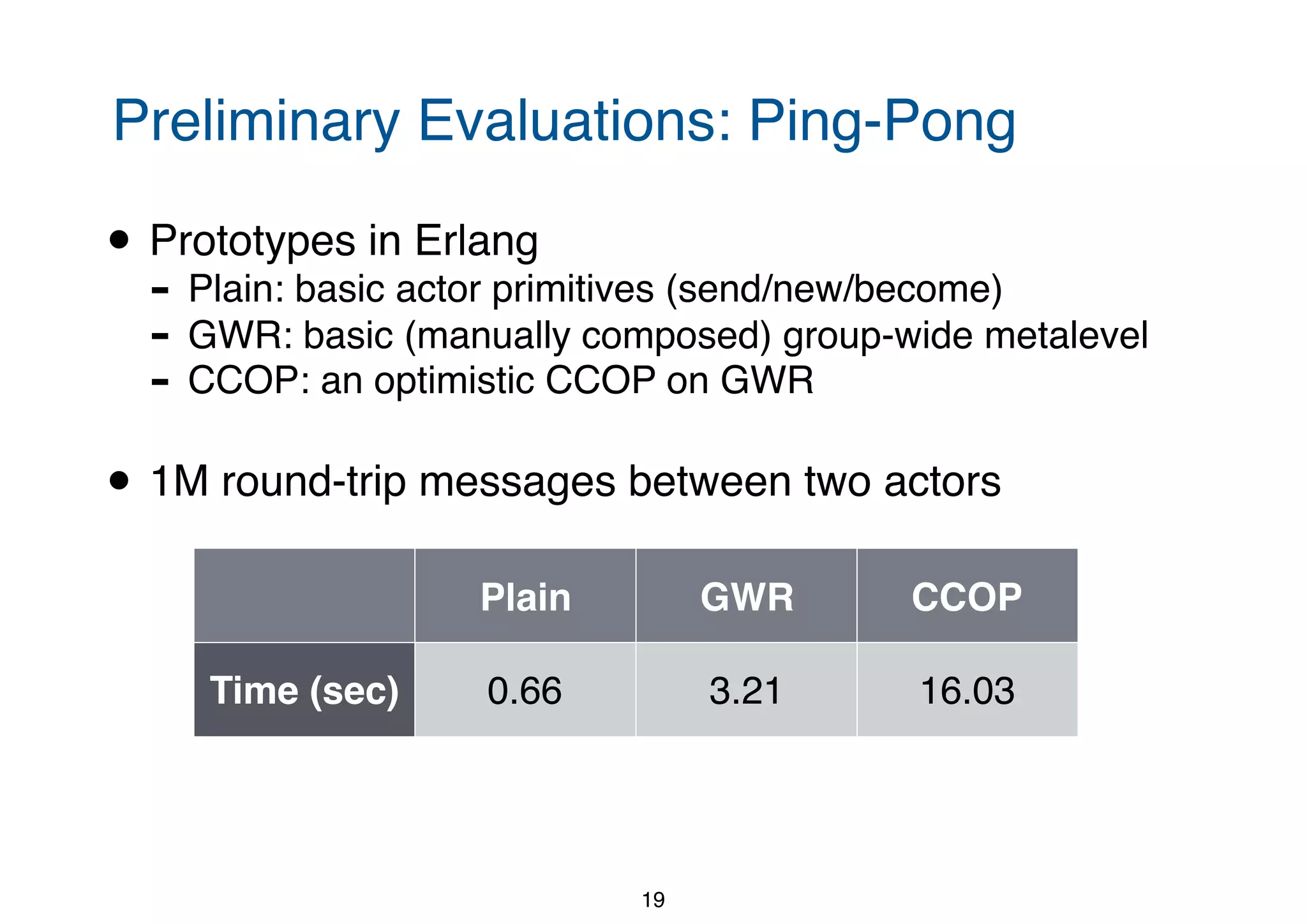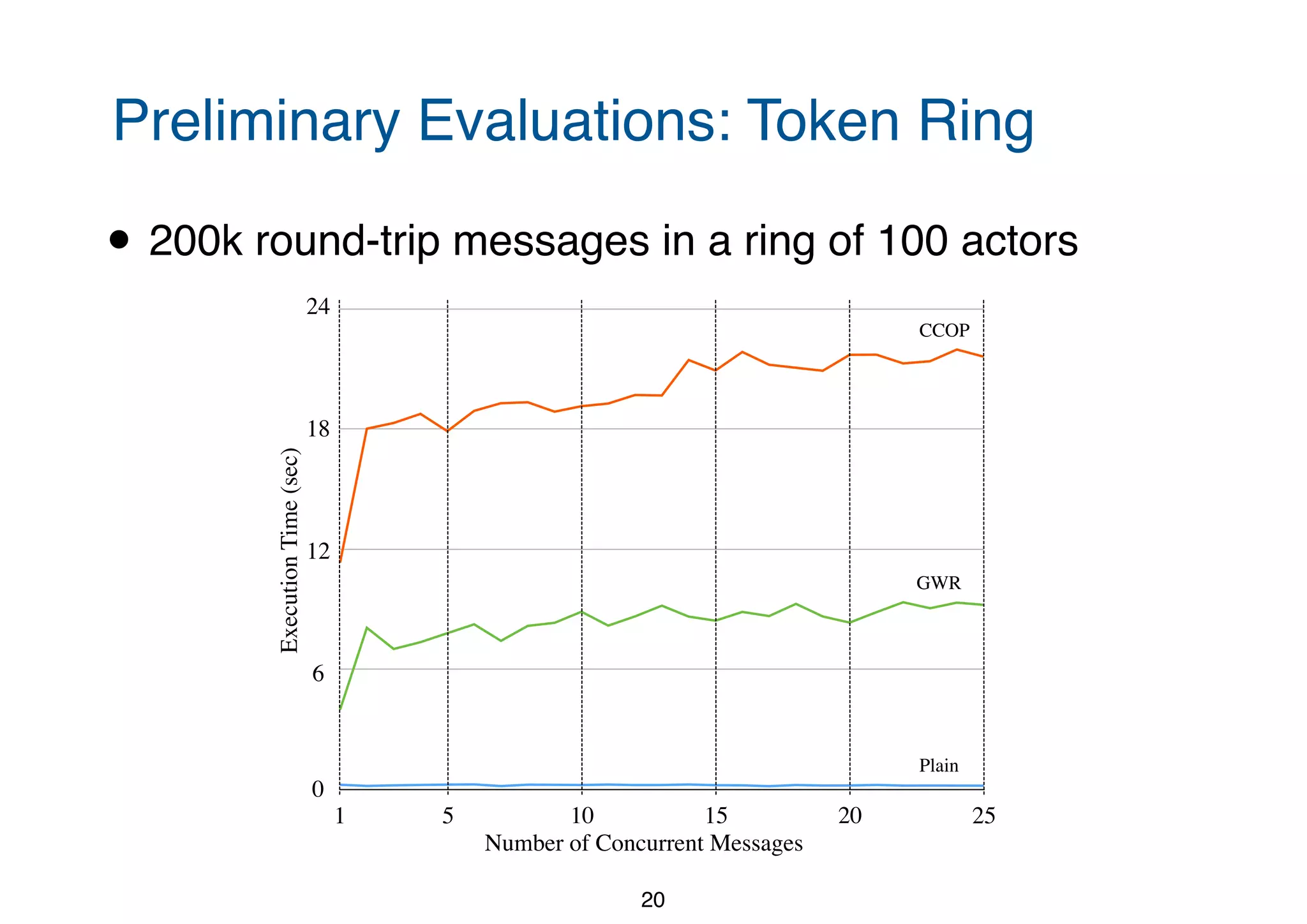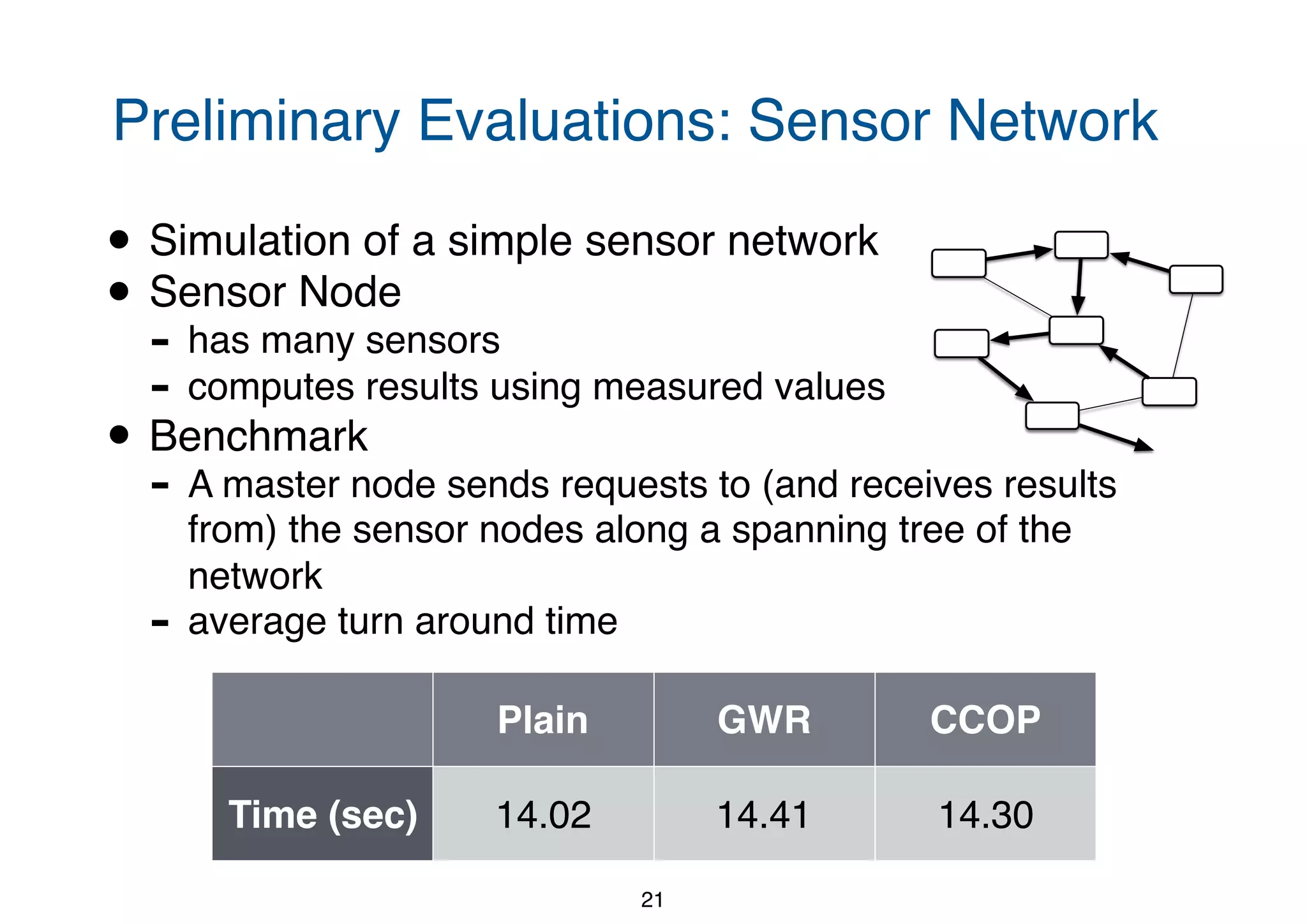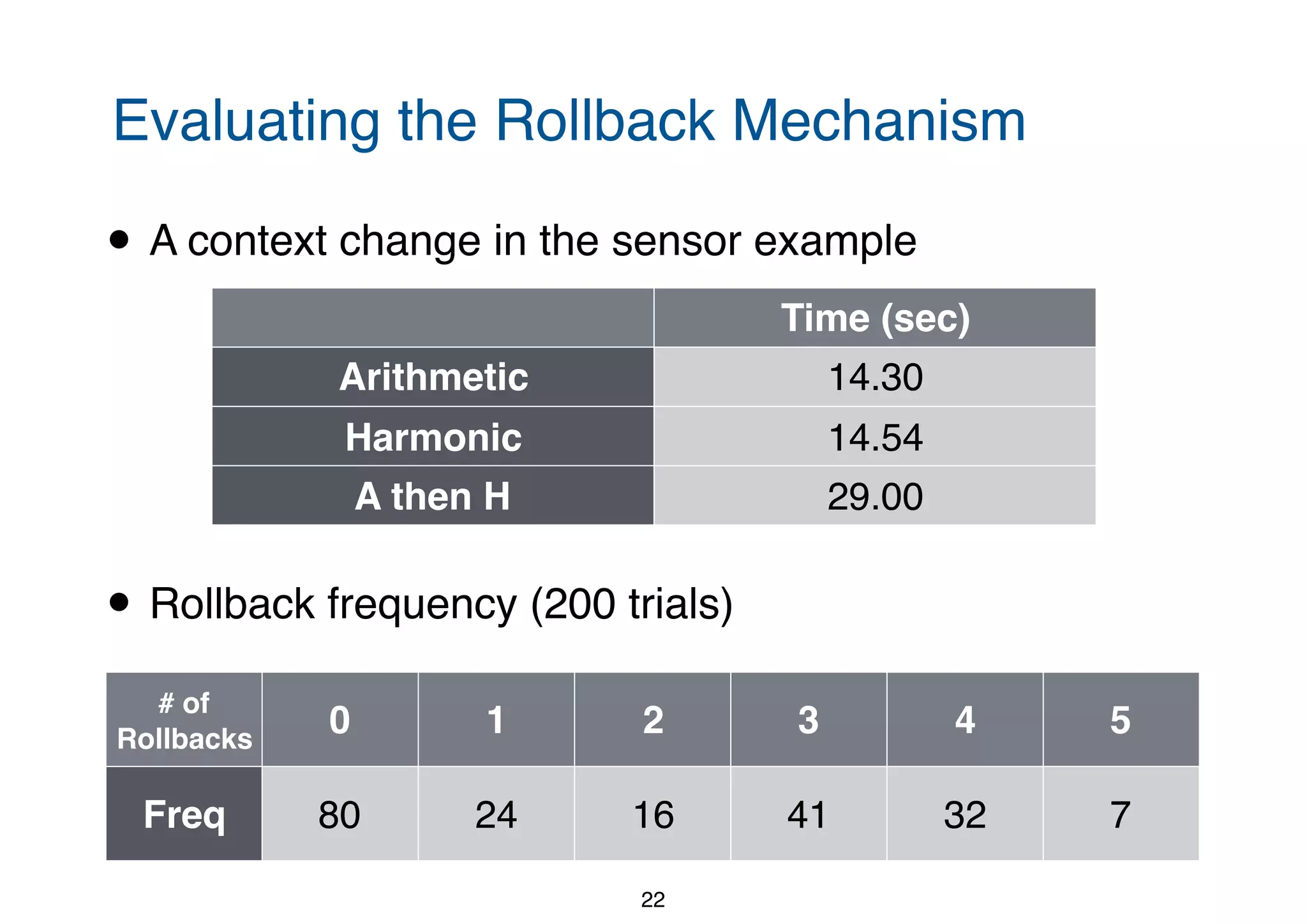This document introduces a new reflective architecture for actor-based concurrent context-oriented systems. It proposes applying group-wide reflection through parallel composition of actors to provide a solution to synchronization problems that can occur when changing contexts asynchronously in a context-oriented programming system. The key aspects are applying actor composition to construct a group-wide meta-level that can perform strictly synchronized context changes to avoid issues with messages crossing context borders. This is evaluated through prototypes implemented in Erlang.
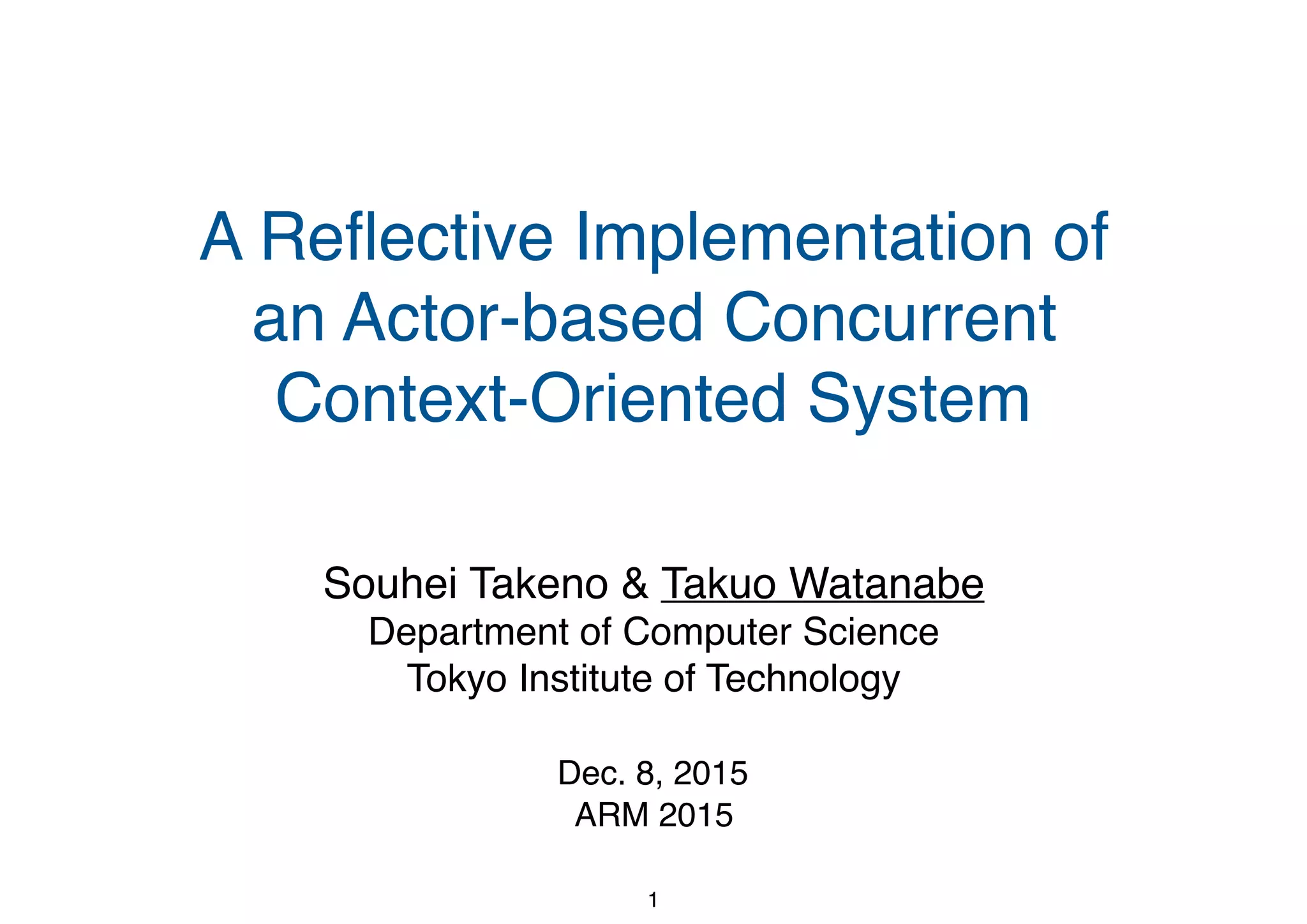

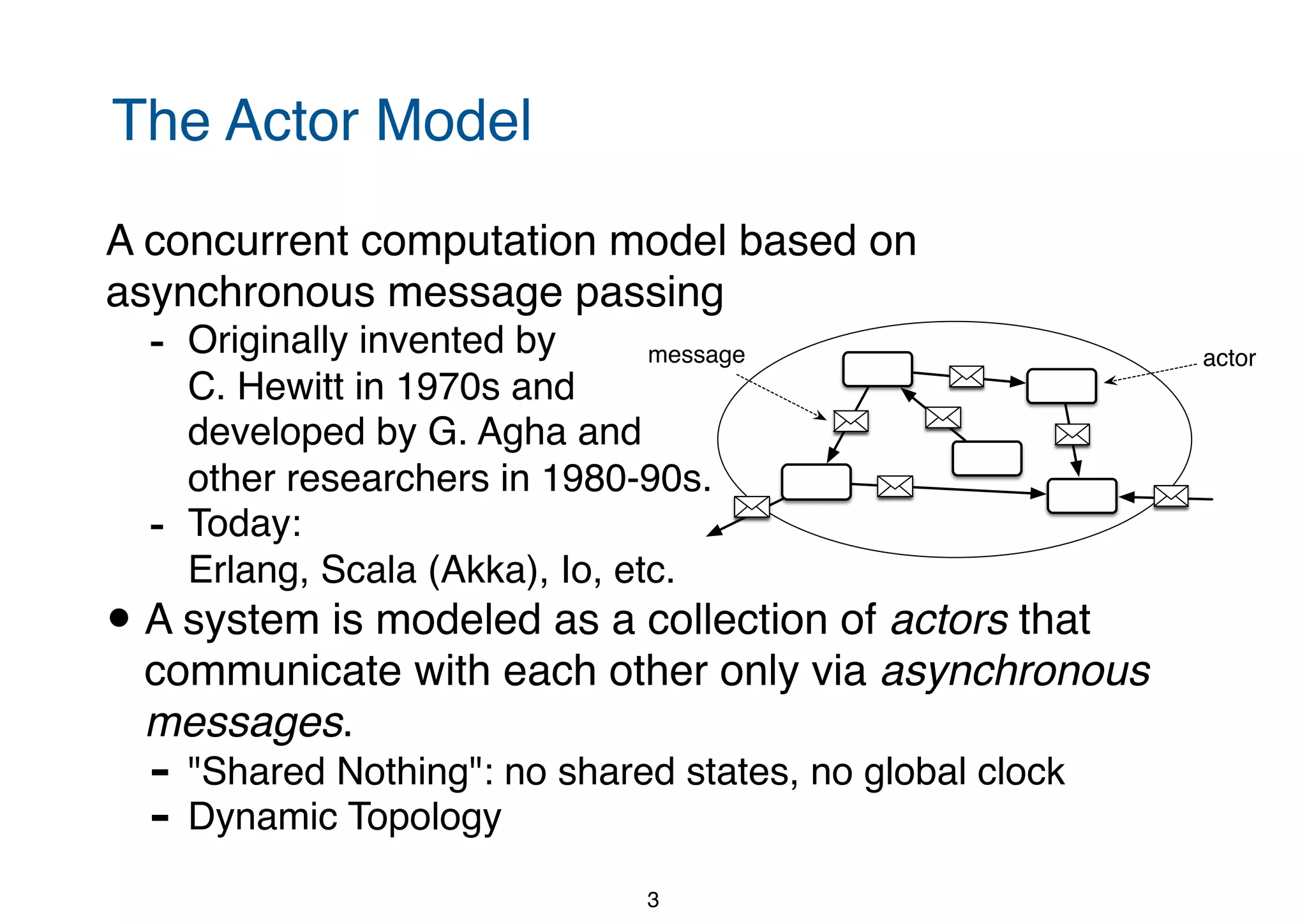
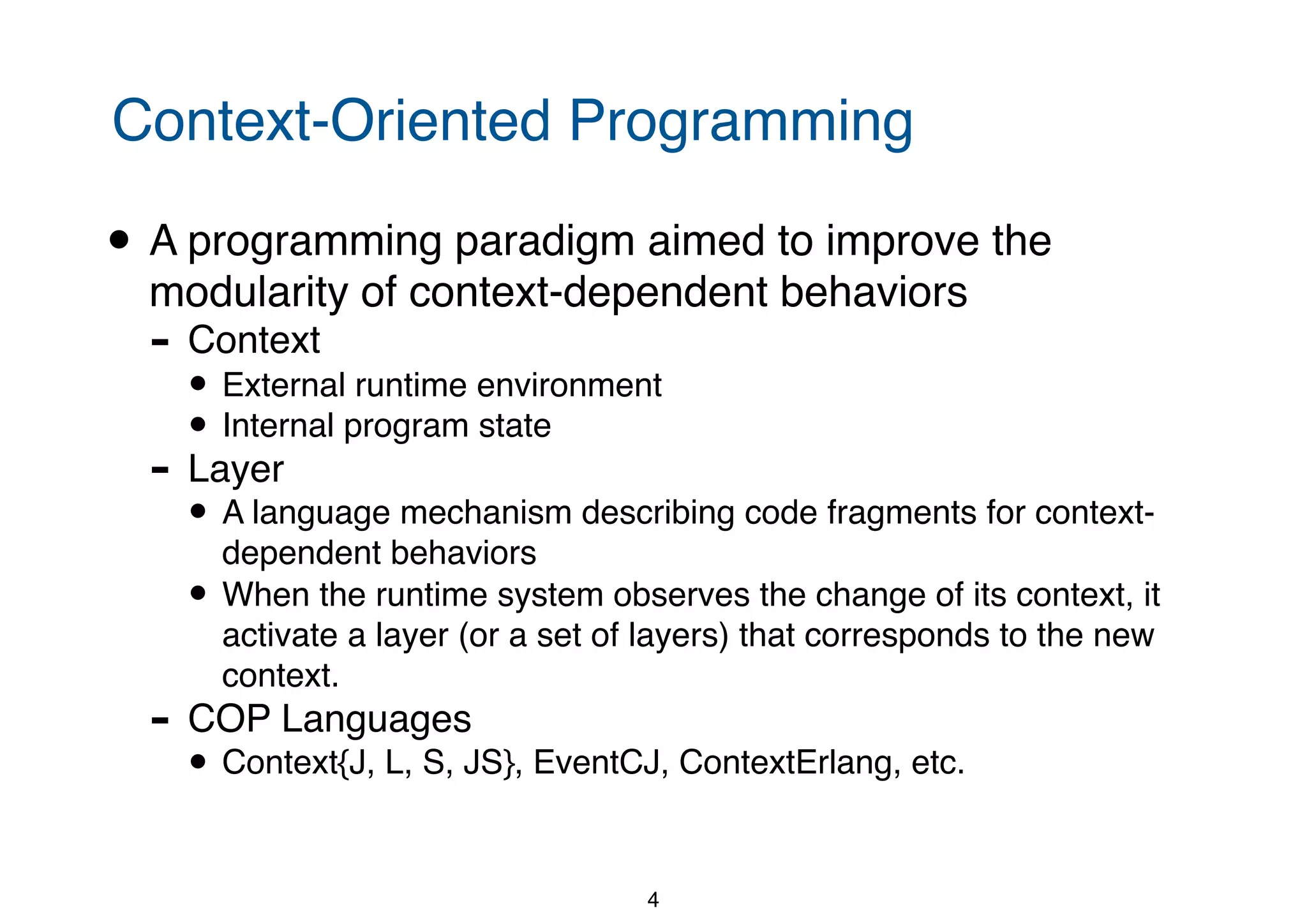
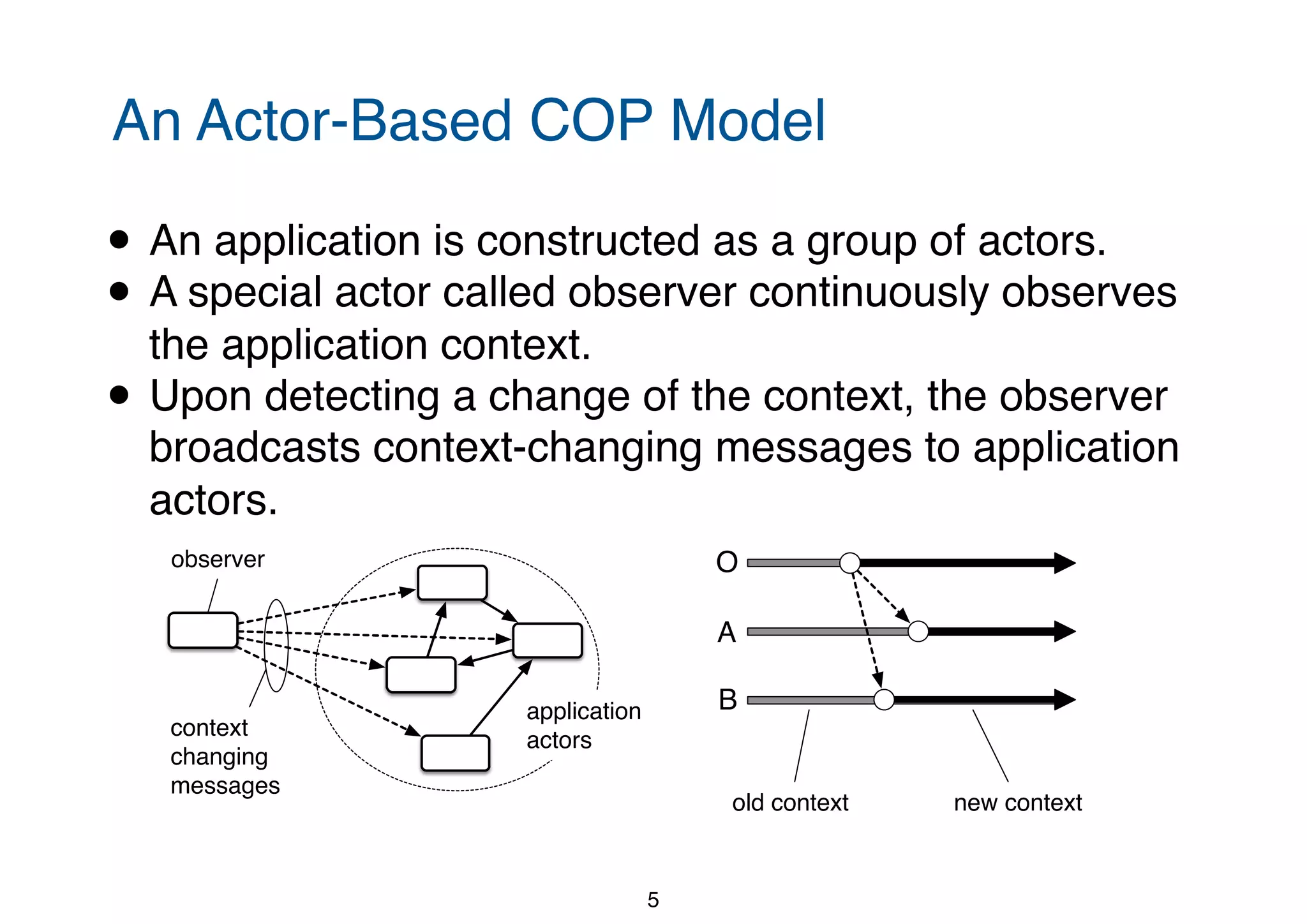
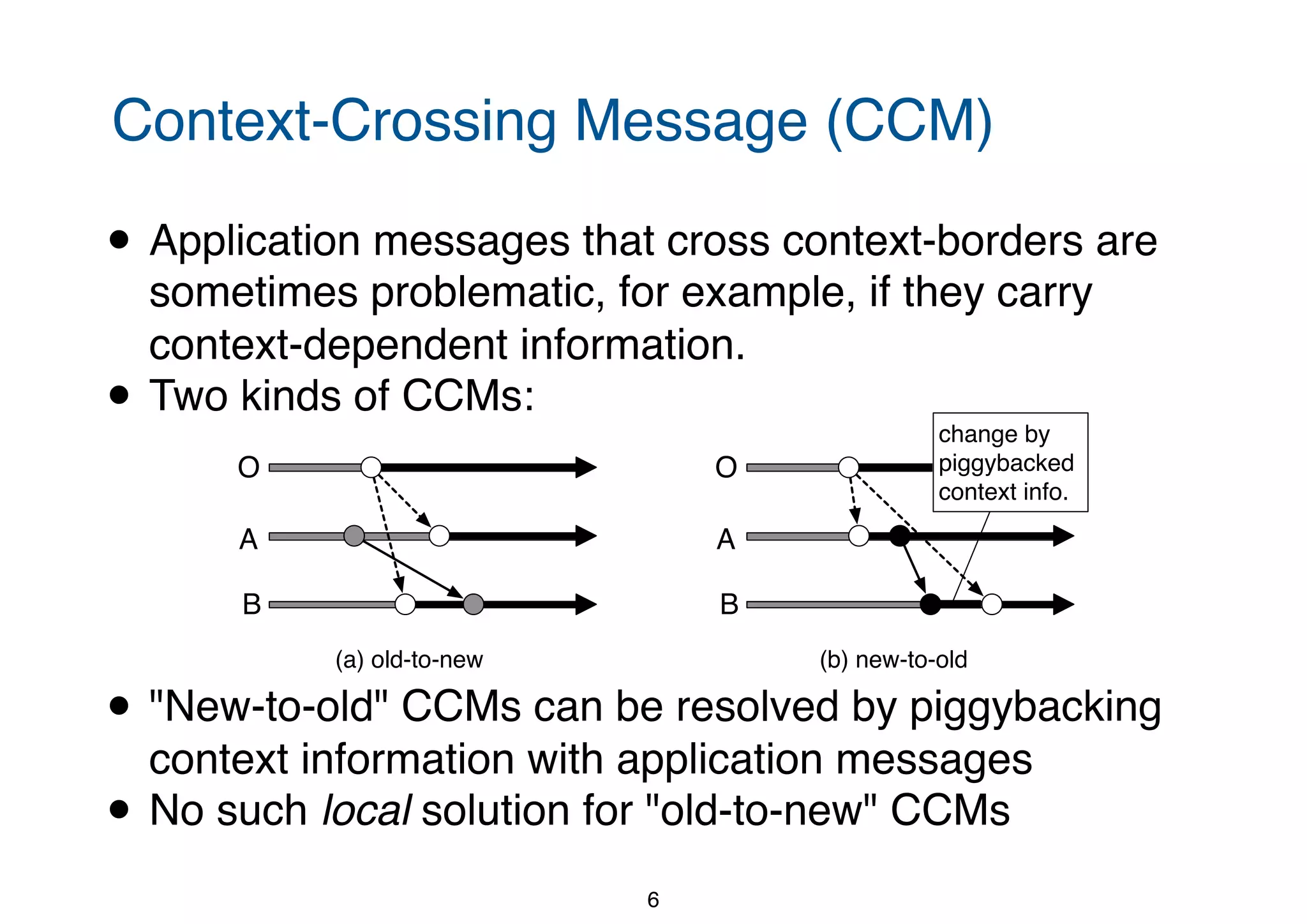
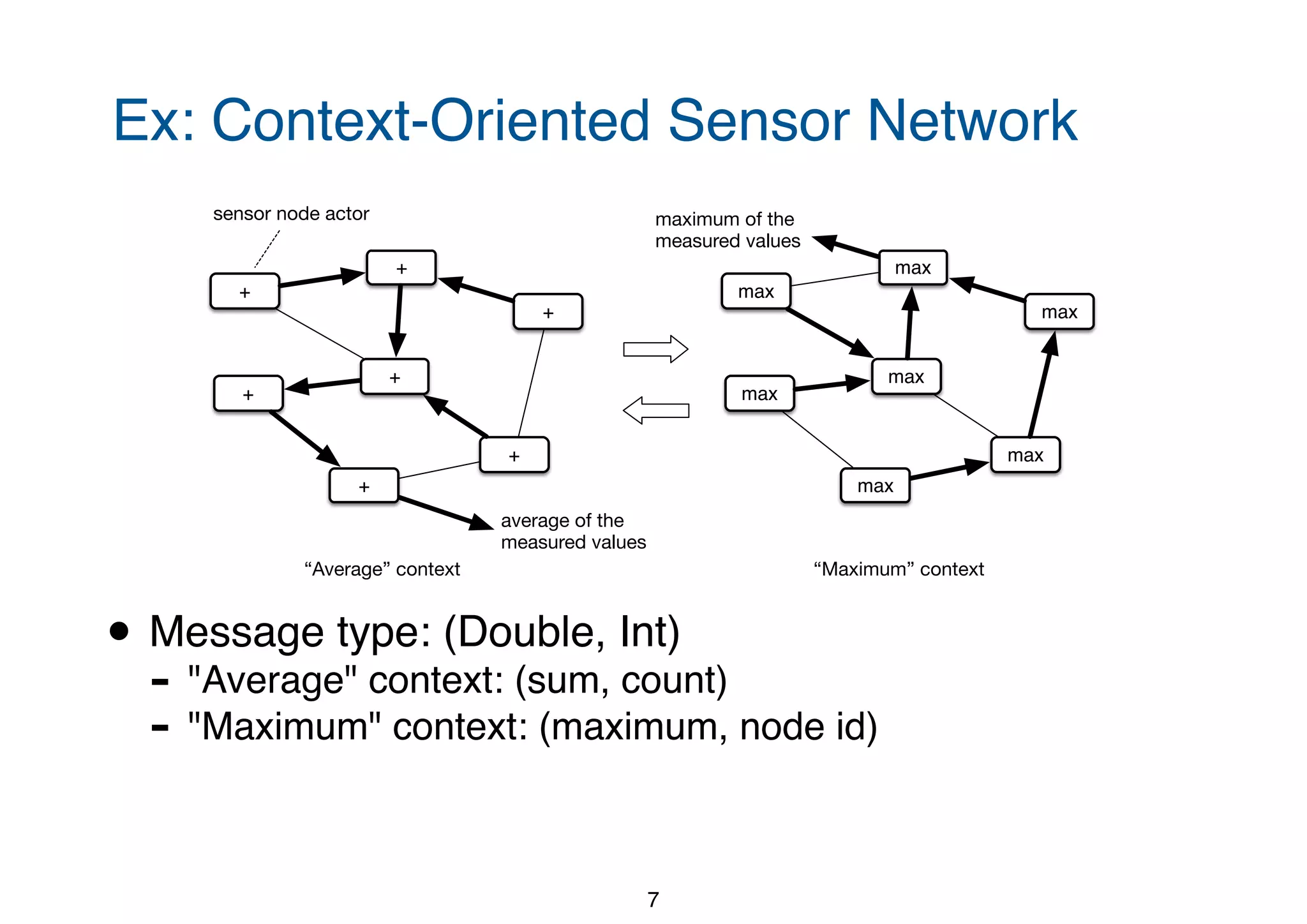
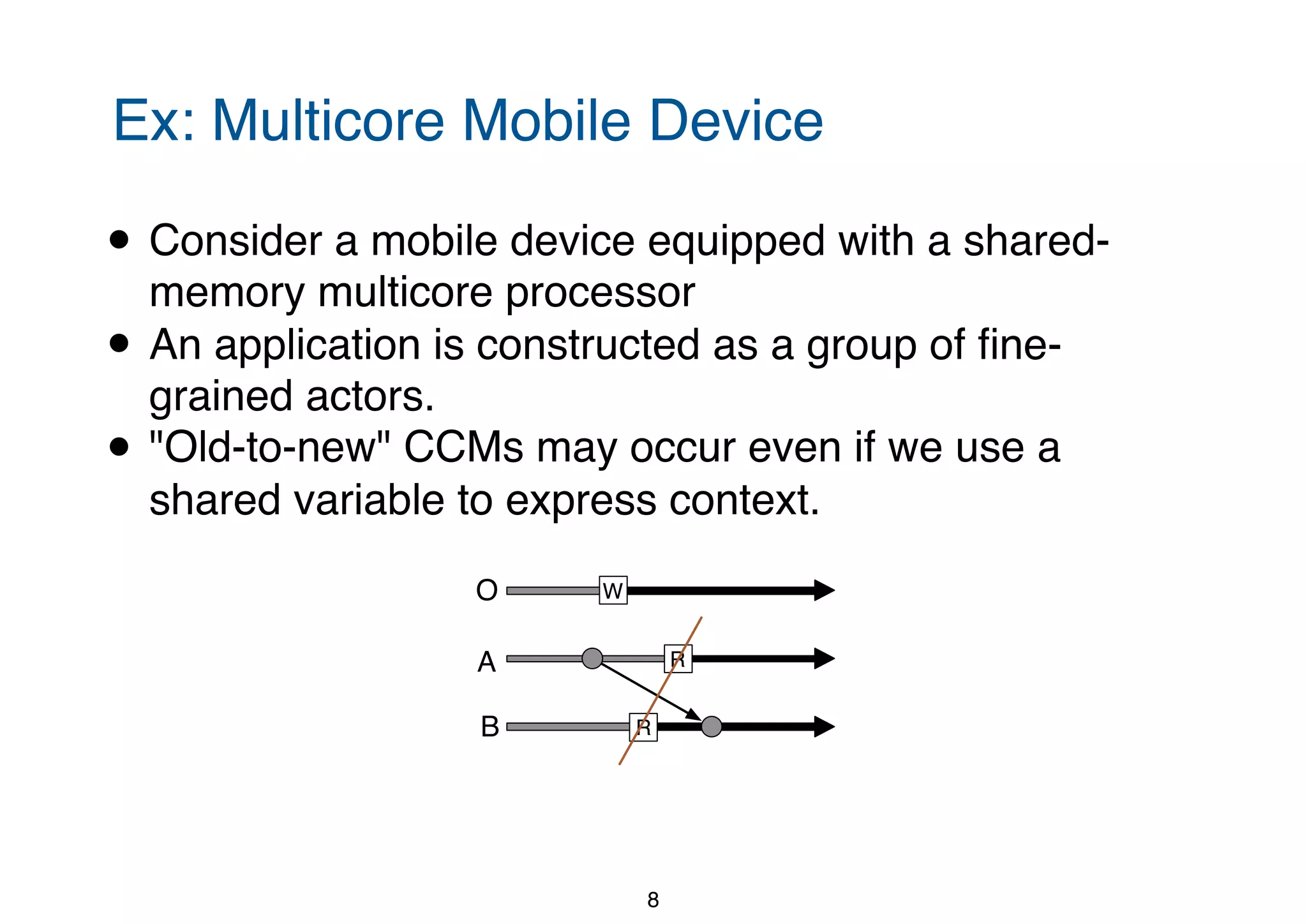
![Related Work • COP in Concurrent Settings - ContextErlang [Salvaneschi et al. '12] • Prohibits in-method context-changing • Does not provide solutions to CCMs - CoElektra [Raab '15] • Limiting the changes of contexts to synchronization points • Needs explicit specification of synchronization points • (Global) Synchronization Mechanisms for Actors - Synchronizers [Frølund '96] - Directors [Varela et al. '99] - Transactors [Field et al. '05] - ARC [Ren et al. '06] - Domains [De Koster et al. '12] 9](https://image.slidesharecdn.com/talk-160714045816/75/A-Reflective-Implementation-of-an-Actor-based-Concurrent-Context-Oriented-System-9-2048.jpg)
![Contribution • Optimistic CCOP using Group-Wide Reflection (GWR) - GWR via parallel actor composition [Watanabe, 2013] • Strictly synchronized context changing (= no CCMs) realized by a customized meta-level actors • Preliminary Evaluations using Prototypes in Erlang 10](https://image.slidesharecdn.com/talk-160714045816/75/A-Reflective-Implementation-of-an-Actor-based-Concurrent-Context-Oriented-System-10-2048.jpg)
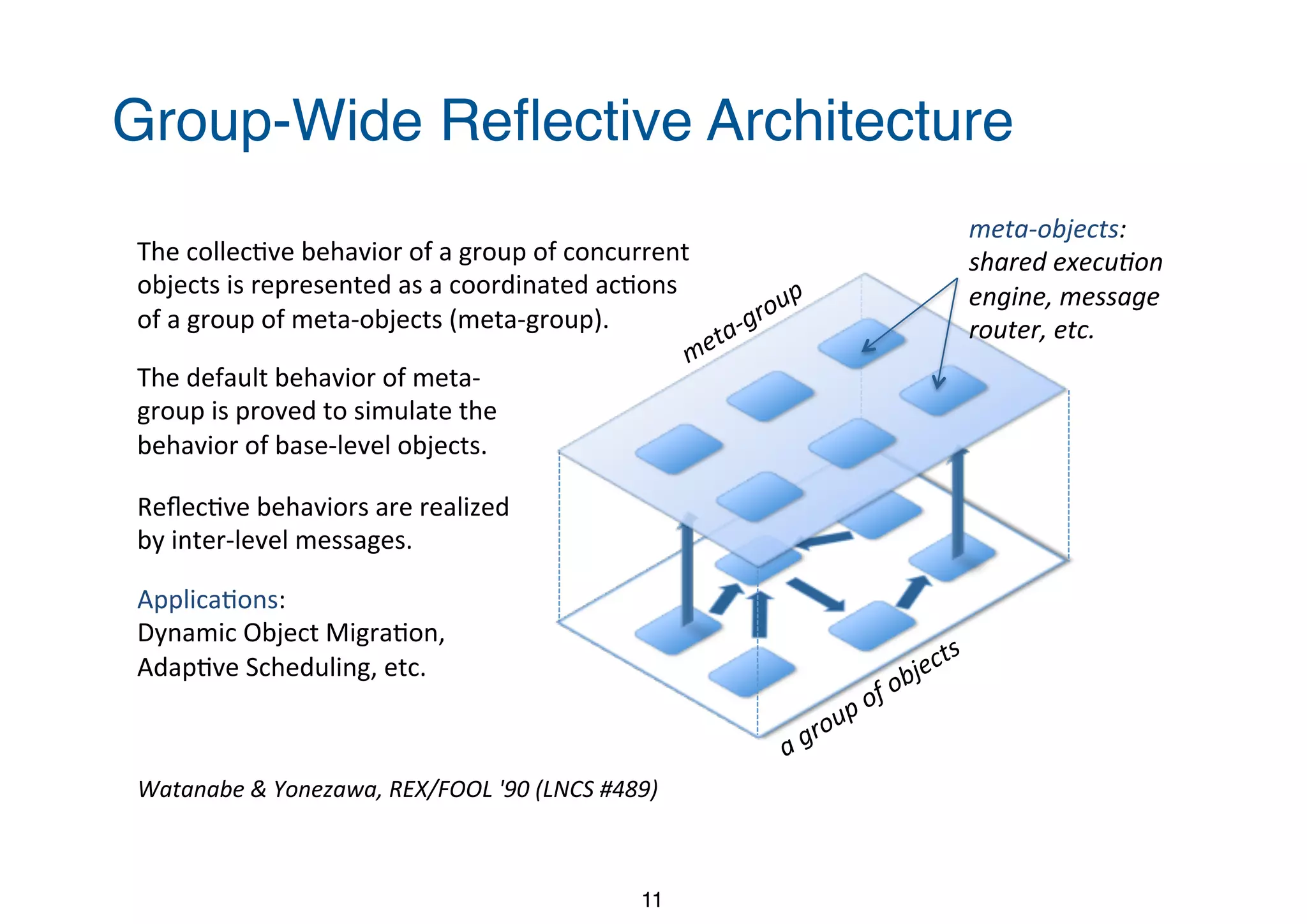
![Ad-hoc, Complex Meta-Levels 12 235 Figure 3: The Individual and Group Reflective Towers in ABCL/R2 objects at the meta-level, we maintain the tower of metaobjects in the same manner as the individual- based architecture. For coordinated management of system resources such as computational resource, we introduce object groups, whose meta-level representation is a group of meta-level objects that are 409 ., .....I,-'S I ! Mailer ~th:task ...] / L _! t+ / S /%. Task I [~'P- III "'i '"?'T- ' I~ "o i / .~ Evaluator Customersof l" I~'It" "". ,, [ ,,. /^~$~" "" TaskHandler I I~Z:'~I Behavior ~".t~ 0"~" [ ~ t'uo-.] --'~ Actors Ix:~" Figure 1: Actors in TS Definition 1 (Metaeonfiguration) Let C be a configuration orS. A metaconfiguration TC E Fls of C is defined as a pair (7"(TC),T(TC)): .A(tc) = {0, ~s, =,~} u E" u Bs T(TC) = {(u, mo, [:task tt Tm Tk]) I(t,m,k) C T(C)} where E A = {e* 1" e X(O)} Bs = {~ I<m, ~) e x(c)} A task (u, mo, [:task Tt tm tk]) 6 T(TC) is called a meta-task of (t,m,k) E T(C). It represents a task (t,m, k) in the object-level (C). We let Tr denote the recta-task of T. We let u denote the tag of the meta-task, me is the mail address of the task handler actor 0 described below, tt and I'm, called a tag handle and a mail address handle1 (or handles in short), are the metalevel representations of the tag t and the mail address m. A handle may denote another handle: ~Tm is also valid. Let 7-/be the domain of handles. The functionality of t is: T:/+M + 7-/-+~ Recall that 27 and M are the domain of tags and the domain of mail addresses. We write for the inverse function of T- For any x E 27+ M + 7-/and y 6 7-/, ~l"x = x and T~y = y holds. Thus T is a bijection, so 7-/should be an (recursive) infinite domain. Handles will be used as keys in the database actor 6s described below. Tk is the value which has the same structure as k, but every occurrence of mail addresses and handles in k are replaced with their handles. For example, if k is the value [:do ma (foo Tmz)] and ml and m~ are mail addresses, then Tk is [:do Tin1 (foo ~Tm2)]. The metalevel actors in .A(TC) are categorized as follows (see Figure 1). Their precise definition will be given as actual code definitions in Section 2.4. Watanabe & Yonezawa, REX/FOOL '90 (LNCS#489) Matsuoka, Watanabe & Yonezawa, ECOOP '91 Masuhara, Matsuoka, Watanabe & Yonezawa, OOPSLA '92 Hard to customize / reason about](https://image.slidesharecdn.com/talk-160714045816/75/A-Reflective-Implementation-of-an-Actor-based-Concurrent-Context-Oriented-System-12-2048.jpg)
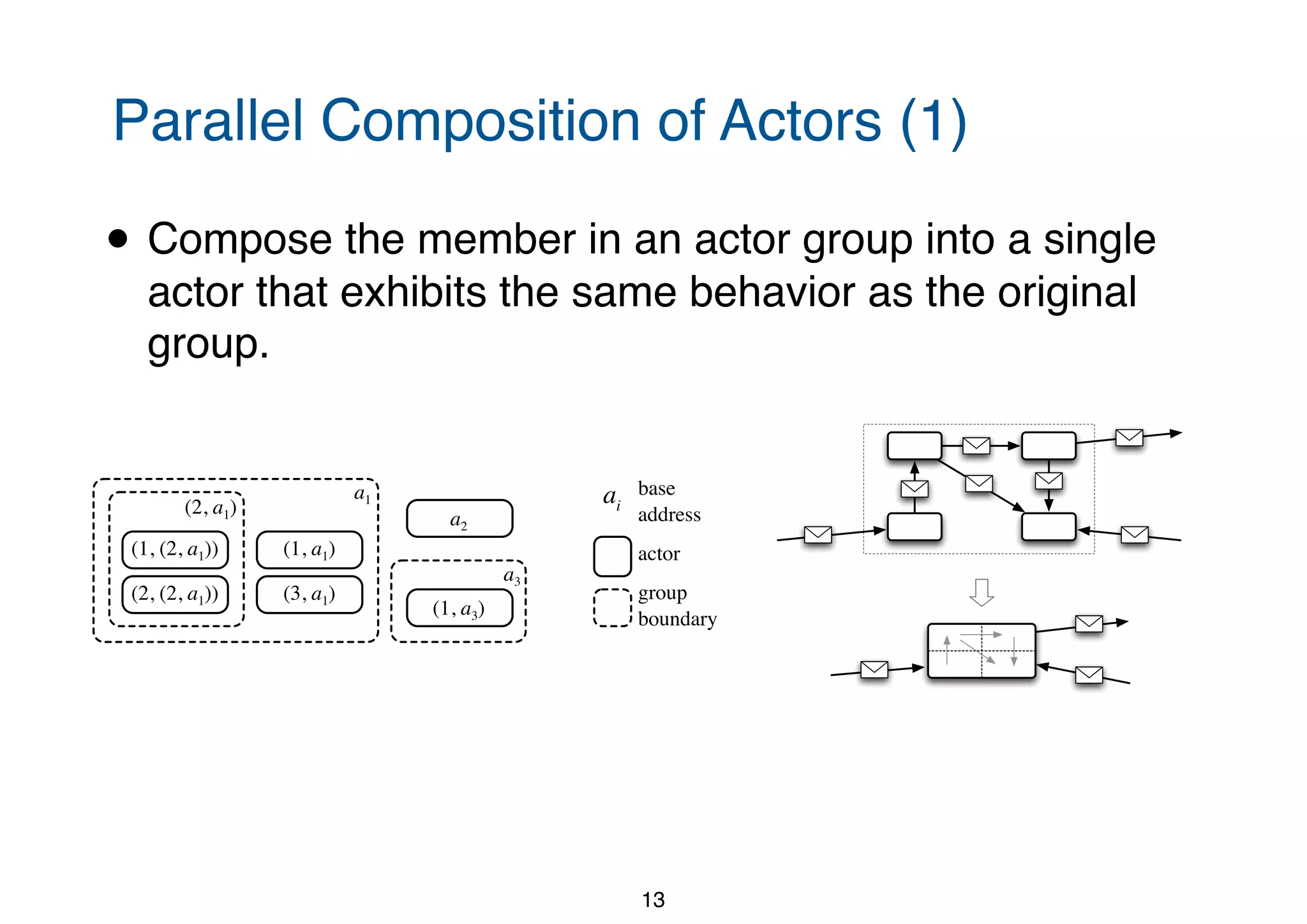

![• By applying the parallel composition to per-actor meta- level definition, we can acquire a group-wide meta-level. • Group-wide operations can be added to the composed meta-level. Compositional Construction of Group-Wide Meta-level[Watanabe 2013] 15 | [] → become meta1(queue , beh , Dormant , exec1) | _::_ → [self ⇐ Begin]; become meta1(queue , beh , state , exec1) end } Figure 6: A Plain Single Meta-Level Behavior letrec metaG(queue*, beh*, state*, execG) = { (i, Mesg v) → if state*[i] = Dormant then [self ⇐ (i, Begin )]; become metaG(queue*{queue*[i] ++ [v]/i}, beh*, state*{ Active/i}, execG) | (i, Begin) → match queue*[i] with | v::queue ’ → [execG ⇐ (i, Apply(beh*[i], v, self )]; become metaG(queue*{queue ’/i}, beh*, state*, execG) end | (i, End) → match queue*[i] with | [] → become metaG(queue*, beh*, state*{ Dormant/i}, execG) | _::_ → [self ⇐ (i, Begin )]; become metaG(queue*, beh*, state*, execG) end } Figure 7: The Composed Meta-Level Behavior Figure 6 is an example of a default (plain) behavior func- tion for meta-level actors. The argument of the function meta1 is a quadruple of the message queue, the behavior function, the state of the base-level and the address of an actor called execution engine. A meta-level actor governs a single base-level actor. As in ABCL/R, the reception of a message m at the base-level is interpreted as the reception of the message Mesg m at the meta-level. Then the meta-level actor maintains its mes- use so The e x*{v/i its i-t The in [17 execut compo spond such a 3. T Usin ous so collect a poss in the Figu a com messa actor memb keeps A c Ctx c w sage. if c′ i in the inform text o newer the m the op handle simple tent. T the Ti Figu timist tings i contex cation applic old co letrec meta1(queue , beh , state , exec1) = { Mesg v → if state = Dormant then [self ⇐ Begin ]; become meta1(queue ++[v], beh , Active , exec1) | Begin → match queue with | v::queue ’ → [exec1 ⇐ Apply(beh , v, self )]; become meta1(queue ’, beh , state , exec1) end | End → match queue with | [] → become meta1(queue , beh , Dormant , exec1) | _::_ → [self ⇐ Begin ]; become meta1(queue , beh , state , exec1) end } Figure 6: A Plain Single Meta-Level Behavior letrec metaG(queue*, beh*, state*, execG) = { (i, Mesg v) → if state *[i] = Dormant then [self ⇐ (i, Begin )]; become metaG(queue *{ queue *[i] ++ [v]/i}, beh*, state *{ Active/i}, execG) | (i, Begin) → match queue *[i] with | v::queue ’ → [execG ⇐ (i, Apply(beh*[i], v, self )]; become metaG(queue *{queue ’/i}, beh*, explosion of composed behaviors. The trick is that every become invocation in the definition uses the same meta-level definition meta1. Figure 7 shows the result of the composition. To im- plement the behavior of each base-level actor, we need to change the argument of meta1 to the quadruple of collec- tive (indexed) data structures (e.g., arrays or dictionaries) other than the execution engine. In the rest of the paper, we use identifiers end with asterisk (such as queue*, beh* and state*) to denote such collective data structures. We also use some built-in operators regarding these data structures. The expression x*[i] denotes the i-th element of x* and x*{v/i} denotes the data structure same as x* except that its i-th element is replaced by v. The execution engine can be shared within the group as in [17, 8]. In this example, execG is responsible for the execution of all members of the group represented by the composed meta-level actor. This architecture roughly corre- sponds to queue-based concurrent task management systems such as libdispatch1 . 3. TOWARDS CONCURRENT COP Using the composed meta-level actor, we can enjoy vari- ous sorts of group-wide reflective operations that control the collective behaviors of an actor groups. This section presents a possible solution to the synchronization problem described in the Section 1 using group-wide reflection. Figure 8 shows the definition of the behavior function of a composed meta-level actor that can cancel cross-context messages within the group governed by this. The meta-level per-actor meta-level group-wide meta-level](https://image.slidesharecdn.com/talk-160714045816/75/A-Reflective-Implementation-of-an-Actor-based-Concurrent-Context-Oriented-System-15-2048.jpg)
![Application: Optimistic CCOP [Watanabe & Takeno 2013] • Assumptions - single observer - contexts are linearly ordered - each message piggybacks the context of its sender • Algorithm - Similar to Timewarp [Jefferson '85] • Better concurrency - cf. pessimistic approach • Implicit - Application programmer doesn't need to take care of context synchronization 16](https://image.slidesharecdn.com/talk-160714045816/75/A-Reflective-Implementation-of-an-Actor-based-Concurrent-Context-Oriented-System-16-2048.jpg)
